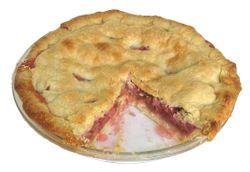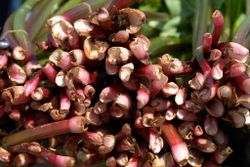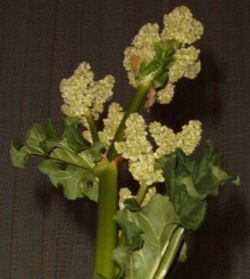Rhubarb
2007 Schools Wikipedia Selection. Related subjects: Food and agriculture; Plants
| iRhubarb | ||||||||||||
|---|---|---|---|---|---|---|---|---|---|---|---|---|
 |
||||||||||||
| Scientific classification | ||||||||||||
|
||||||||||||
|
|
||||||||||||
|
About 60, including:
|
Rhubarb is a perennial plant that grows from thick short rhizomes, comprising the genus Rheum. The large, somewhat triangular leaf blades are elevated on long, fleshy petioles. The flowers are small, greenish-white, and borne in large compound leafy inflorescences.
Cultivation and use
The plant is indigenous to Asia, and many suggest that it was often used by the Mongolians; particularly, the Tatars tribes of the Gobi. Varieties of rhubarb have a long history as medicinal plants in traditional Chinese medicine, but the use of rhubarb as food is a relatively recent innovation, first recorded in 17th century England, after affordable sugar became available to common people.
Rhubarb is now grown in many areas, primarily for its fleshy petioles, commonly known as rhubarb sticks. In temperate climates rhubarb is one of the first food plants to be ready for harvest, usually in mid to late Spring (April/May in the Northern Hemisphere, October/November in the Southern). The petioles can be cooked in a variety of ways. Stewed, they yield a tart sauce that can be eaten with sugar or used as filling for pies (see rhubarb pie), tarts, and crumbles. This common use led to the slang term for rhubarb, "pie plant" (piestengel in German). Cooked with strawberries as a sweetener, rhubarb makes excellent jam. It can also be used to make wine.
In former days, a common and affordable sweet for children in parts of the United Kingdom was a tender stick of rhubarb, dipped in sugar. In the UK the first rhubarb of the year is grown by candlelight in dark sheds dotted around the noted " Rhubarb Triangle" of Wakefield, Leeds and Morley.
In warm climates, rhubarb will grow all year round, but in colder climates the parts of the plant above the ground disappear completely during winter, and begin to grow again from the root in early spring. It can be forced, that is, encouraged to grow early, by raising the local temperature. This is commonly done by placing an upturned bucket over the shoots as they come up.
Species
The plant is represented by about 60 extant species. Those most commonly used in cooking are the Garden Rhubarb (R. rhabarbarum) and R. rhaponticum, which, though a true rhubarb, bears the common name False Rhubarb. The drug rheum is prepared from the rhizomes and roots of another species, R. officinale or Medicinal Rhubarb. This species is also native to Asia, as is the Turkey Rhubarb (R. palmatum). Another species, the Sikkim Rhubarb (R. nobile), is limited to the Himalayas.
Rhubarb is used as a strong laxative and for its astringent effect on the mucous membranes of the mouth and the nasal cavity.
Rheum species have been recorded as larval food plants for some Lepidoptera species including Brown-tail, Buff Ermine, Cabbage Moth, Large Yellow Underwing, The Nutmeg, Setaceous Hebrew Character and Turnip Moth.
Toxic effects
Rhubarb leaves contain poisonous substances. Rhubarb leaf poisoning is most often caused by oxalic acid, a corrosive and nephrotoxic acid that is abundantly present in many plants. The LD50 for pure oxalic acid is predicted to be about 375 mg/ kg body weight, or about 25 g for a 65 kg human. While the oxalic acid content of rhubarb leaves can vary, it averages about 0.5%, so a rather unlikely five kilograms of the extremely sour leaves would have to be consumed to reach an LD50 dose. In the petioles, the amount of oxalic acid is much lower, especially when harvested before mid-June (in the northern hemisphere), but it is still enough to cause slightly rough teeth.
The roots and stems are rich in anthraquinones, such as emodin and rhein. These substances are cathartic and laxative, which explains the sporadic abuse of Rhubarb as a slimming agent. Anthraquinones are yellow or orange and may colour the urine.
Other uses of the word
It is or was common for a crowd of extras in acting to shout the word "rhubarb" repeatedly and out of step with each other, to cause the effect of general hubbub. As a result, the word "rhubarb" sometimes is used to mean "length of superfluous text in speaking or writing", or a general term to refer to irrelevant chatter by chorus or extra actors.
Possibly from this usage, possibly from a variant on " rube", or perhaps some of both, the word also denotes a loud argument. The term has been most commonly used in baseball.
In the 1989 film Batman, The Joker ( Jack Nicholson) tells Bruce Wayne ( Michael Keaton) to "never rub another man's rhubarb". The term was used as a threat to Bruce Wayne warning him to leave both men's love interest Vicki Vale ( Kim Basinger) alone.
Trivia
Rhubarb is sometimes considered a vegetable (based on its appearance and being a close relative of Sorrel) and sometimes considered a (culinary) fruit (based on how it is eaten).
"Donkey Rhubarb" is used as a term when referring to the drug-oriented uses of cannabis. For example, the word takes the place of words such as "weed" or "pot" in some places in Canada.
Rhubarb, specifically in the form of the ficitious product "Be-Bob-A-Re-Bob Rhubarb Pie", is frequently mentioned in ' A Prarie Home Companion'. In the 2006 film adaptation of the program, the pies are not mentioned, but rhubarb itself is, including an explanation of the source of the name.


